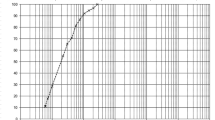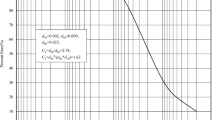Abstract
An experiment was performed to study the influence of polymer binders on the physical properties, and stability against a simulated rainfall, of a slope consisting of engineering spoil. Results showed that low polymer binder concentrations (≤500 g/m3) could enhance the air permeability and moisture -retaining capacity of the engineering spoil; however, adding more polymer binder made the hardness of the engineering spoil increase and then decline. With the increase of polymer binder concentrations, the surface (0–5 cm) permeability of the engineering spoil decreased but the permeability of the lower layers (5–10 cm) increased. Polymer binders might reduce runoff and sediment, but the effect becomes weaker with the increase of rainfall. The results of this study have significance for engineering practices. Further experiments are needed to study the effects of binders under other conditions, such as natural rainfall, different slopes, different rock types, different degrees and spoil weathering and different added material, and the chemical interaction between soil and polymer binders.
Similar content being viewed by others
References
BAST-E9 (1971) Usability of the country rock of hard coal as bulk material for roads. Federal Road Administration. (In German)
Ben-Hur M, Letey J (1989) Effect of polysaccharides, clay dispersion, and impact energy on water infiltration. Soil Science Society of America Journal 53: 233–238.
Ben-Hur M, Letey J, Shainberg I (1990) Polymer effect on erosion under laboratory rainfall simulator conditions. Soil Science Society of America Journal 54: 1092–1094.
BS-6543 (1985) British Standards Guide to the Use of Industrial By-Products and Waste Materials in Building and Civil Engineering. British Standards Institute, London.
Cao SG (1961) The hardness index of paddy soil and its application. Soil 9: 7–12. (In Chinese)
Cao ZL, Zheng CL (2009) The soil erosion present status of highway construction project in China. Shanxi Architecture 35(11): 340–341. (In Chinese)
Čermák L (1972) Use of waste for the construction of dykes. Projects-Issues 12: 4–9. (In Polish)
Chen MD, Li YJ, Chen YJ (2003) Study on the application of the “ON” spray vegetation method in protecting the rocky slope. Subgrade engineering 109: 67–70. (In Chinese)
Chen NS, Zhou W, Yang CL, et al. (2010) Prevention and control mode of construction spoils-induced debris flow hazards and its application. Ming Research and Development 30(4): 84–87. (In Chinese)
Cui HY, Ren SM, Liu D, et al. (2006) A study of influence of polyacrylamide on runoff and sediment generation on different soil slope. Soil and Water Conservation of China 2: 20–22. (In Chinese)
Feng H, Wu SF, Wu PT (2006) Effect of macromolecule polymers on soil physical characteristics and runoff and sediment generation on slopeland. Science of Soil and Water Conservation 4(1): 15–19. (In Chinese)
FGSV 616/2 (1984) Information concerning the reuse of industrial by-products in road building. Research company for roads and transport essential. Working Group: Minerals in the Road, Cologne. (In German)
Gao GJ, Zeng XL (2009) Effect of water absorbent polymer on properties of soil substrate used on high and steep rocky slope. Pratacultural Science 26(4): 154–158. (In Chinese)
Guthrie P, Mallett H (1995) Waste minimisation and recycling in construction — a review. Special Publication 122, CIRIA, London.
Han CX, Yuan ZY (2002) Effects on soil and water loss from spoil and its control. Soil and Water Conservation Science and Technology in Shanxi 2: 26–27. (In Chinese)
Huang BZ, Cao WB, Chen ZZ (1999) The Lawn Nutrition and Fertilization. China Forestry Publishing House. pp 3–4, 101–102. (In Chinese)
Huang C, Wells LK, Norton LD (1999) Sediment transport capacity and erosion processes: Model concepts and reality. Earth Surface Process Landforms 24: 503–516.
Kristian AJ, Bjorneberg DL, Sojka RE (1998) Sprinkler irrigation runoff and erosion control with polyacrylamidelaboratory tests. Soil Science 62: 1681–1687.
Kwan JCT, Jardine FM (1999) Ground engineering spoil: practices of disposal and reuse. Engineering Geology 53: 161–166.
Leininger D, Erdmann W, Köhling R, et al. (1983) Recent development in the utilization of preparation refuse in the Federal Republic of Germany. Symposium on the Utilization of Waste from Coal Mining and Preparation 22.Tatabanya, Hungary.
Lentz RD (2003) Inhibiting water infiltration with polyacrylamide and surfactants: Applications for irrigated agriculture. Soil and Water Conservation 58(5): 290–299.
Lentz RD, Shainberg I, Sojka RE, et al. (1992) Preventing irrigation furrow erosion with small applications of polymers. Soil Science 56: 1926–1932.
Lentz RD, Sojka RE (1994) Field results using polyacrylarnide to manage furrow erosion and infiltration. Soil Science 158(4): 274–282.
Li SC, Sun HL, Yang ZR, et al. (2006) Effect of straw fiber polyacrylamide and super absorbent polymer eco-engineering on rock slope protection. Chinese Journal of Rock Mechanics and Engineering 25(2): 257–267. (In Chinese)
Pan YH, Lei TW, Gu XY (2007) Influence of PAM and PG on Horizontal Infiltration. China Rural Water and Hydropower 12: 17–21. (In Chinese)
Skarżyńska KM (1995) Reuse of coal mining wastes in civil engineering part2: utilization of minestone. Waste Management 15(2): 83–126.
Smith HJC, Levy GJ, Shainberg I (1990) Water-droplet energy and soil amendments: Effect on infiltration and erosion. Soil Science Society of America Journal 54: 1084–1087.
Sojka RE, Lentz RD (1994) Time for yet another look at soil conditioners. Soil Science 158: 233–234.
Wang CQ, Xie DL, Li B, et al. (2004) Studies on dynamic change of pH to different composition ratio of slope nutrition layer materials. Journal of Soil and Water Conservation 18(6): 74–78. (In Chinese)
Whitbread M, Marsey A, Tunnell C (1991) Occurrence and Utilisation of Mineral and Construction Wastes. Report for the Department of the Environment, HMSO, London.
WKE-R-78156 (1982) The Applicability of heap shale in hydraulic engineering. Delta Panel Inspection Service Building Materials for Hydraulic Engineering, Public Works Department. (In Dutch)
Wu SF, Wu PT, Feng H (2003) A study on influence of macromolecule polymers to soil physical properties. Bulletin of Soil and Water Conservation 23(1): 42–45. (In Chinese)
Yang G, Wang JH, Zhang HD (2009) The technical principle and application of vegetation restoration for CSR rock and soil residue field. Shanxi Architecture 35(1): 9–10. (In Chinese)
Yang XT, Dong HY, Huang YR, et al. (2000) Study on slope stability of expressway in loess region. Journal of Soil and Water Conservation 14(1): 77–81. (In Chinese)
Zhang HM, Peng DS, Xi TX (2005) Study on waste soil and residue prevention and control technologies of highway. Research of Soil and Water Conservation 12(4): 235–237. (In Chinese)
Zhang JR, Xia YF, Gong YL (2003) Study on constitutive relation for eco-material used to slope protection. Journal of Wuhan University Technology 25(8): 36–39. (In Chinese)
Zingg AW (1940) Degree and length of land slope as it affects soil loss in runoff. Agricultural Engineering 21: 59–64.
Zhongdao H (1999) The Handbook of Road Planting. Mountain Begonia Press. p 52. (In Japanese)
Author information
Authors and Affiliations
Corresponding author
Rights and permissions
About this article
Cite this article
Chen, Sy., Gu, W. & Dai, Qy. Influence of polymer binder on the physical properties and stability of engineering spoil on a slope. J. Mt. Sci. 10, 105–115 (2013). https://doi.org/10.1007/s11629-013-2222-7
Received:
Accepted:
Published:
Issue Date:
DOI: https://doi.org/10.1007/s11629-013-2222-7




